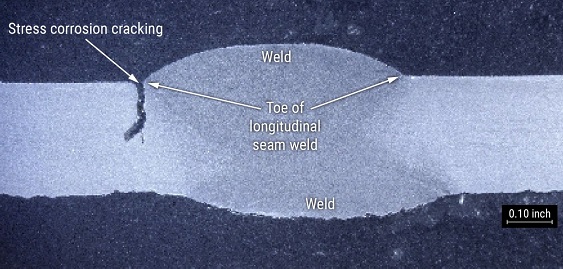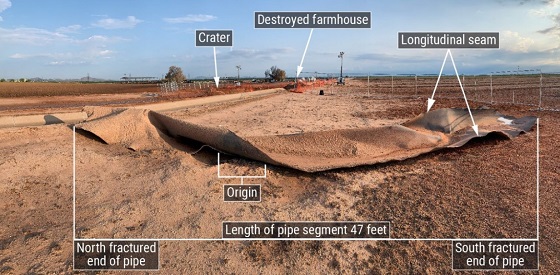U.S. National Transportation Safety Board (NTSB) investigators believe a deadly natural-gas pipeline explosion in rural Arizona resulted from gaps in protective tape wrapping. This led to water leakage and corrosion and cracks along a seam weld, according to NTSB’s probe into the incident from August 15, 2021.
The rupture resulted in the release of natural gas vapor that ignited and exploded, which caused a blast wave and a gas-fed fire. This destroyed a farmhouse in Coolidge, Ariz., USA, located about 451 feet (137.5 m) away, killing two of three occupants while seriously injuring the other.
Several acres of vegetation were damaged in areas nearly 900 feet (274.3 m) away from the rupture crater, while a 47-foot (14.3 m) segment of pipe was ejected about 130 feet (39.6 m) from the crater’s midpoint. Kinder Morgan, which operates and manages the Line 2000 pipeline, estimated property damage and emergency response costs to be approximately $5.5 million.
Initial Incident Response
The rupture location was not designated as a high consequence area (HCA) or moderate consequence area under U.S. Code of Federal Regulations (CFR) Title 49 rules. However, before the accident, Kinder Morgan had voluntarily included the ruptured segment in its integrity management (IM) program as part of a nonregulatory internal program.
In this internal program, pipeline operations were controlled and monitored by a control center in Colorado Springs, Colo., USA. About seven minutes after the rupture, control center personnel received five informational pressure rate-of-change alarms within four minutes, alerting them to a rapid drop in pressure in a pipeline segment near the rupture site.
The operator initiated emergency response activities in accordance with company operations and maintenance procedures. To isolate the affected pipeline segment, Kinder Morgan personnel manually closed three mainline valves near the rupture site. Within three hours, the gas-fed fire was stopped.
At the time of rupture, the operating pressure of Line 2000 was about 863 psig (6.0 MPa), which was below the maximum allowable operating pressure of 944 psig (6.5 MPa). The pipeline was coated with two layers of spiral-wrap tape as its primary means of corrosion protection and supplemented with an impressed current cathodic protection (CP) system. Other specifications are shown in Table 1.

Internal Data Management
Starting in 2014, when field personnel exposed any segment of Line 2000 for defects — including on excavations — they completed a pipeline examination report (PER). The data from PERs was integrated into a pipeline open database standard (PODS).
PODS was Kinder Morgan’s internal data management tool to identify and document pipeline specifications, such as coating type. Data factors in PODS were used as inputs during risk assessments.
Between 2014 and the day of the incident, six PERs were completed within about 2 miles (3.2 km) of the rupture origin. The most recent PER was completed in February 2018.
In these PERs, which were entered into PODS, the coating type for the ruptured pipeline segment was listed as fusion-bonded epoxy (FBE). One data report, submitted in 2011 after a composite sleeve was installed approximately 375 feet (114.3 m) from the rupture location, said the coating type listed as FBE was incorrect and that the actual coating type was spiral-wrap tape. This was not recorded in PODS.
Previous Risk Assessments
At the time of the rupture, Kinder Morgan used a risk assessment algorithm to evaluate all of its segments for threats to pipeline integrity, as identified by the B31.8S standard of the American Society of Mechanical Engineers (ASME).
The algorithm determined the probability of a stress corrosion cracking (SCC) failure by examining near-neutral and high-pH SCC, which are the two SCC types defined in ASME B31.8S.
Kinder Morgan further calculated baseline susceptibility as the direct product of several correlating factors recorded in PODS. These included pipe age; year of installation; pipe manufacturer and mill location; pipe diameter and wall thickness; downstream distance from a compressor station; location of pipe (above or below ground); soil conditions (susceptibility, pH, and resistivity); and coating type.
At the time of rupture, the risk assessment algorithm determined that near-neutral SCC was an active threat to pipeline safety and integrity at milepost 496.9, based on a 2002 hydrostatic test failure. The company’s records listed the coating at that location as a multilayer tape system with urethane foam insulation. Yet, Kinder Morgan did not identify an SCC threat on the ruptured segment at milepost 497.07, which is where the coating type was incorrectly listed as FBE.
Potential Impact Radius
The U.S. Pipeline and Hazardous Materials Safety Administration (PHMSA) requires operators to mathematically calculate a potential impact radius (PIR), or the area where any failure could have a significant impact on people or property. This helps determine whether a pipeline is in an HCA.
Using requirements provided by the regulations, the NTSB calculated the rupture site’s PIR to be 636 feet (193.9 m), which was approximately 250 feet (76.2 m) less than where physical evidence identified during the on-site examination showed damage to surrounding vegetation.
According to NTSB, similar discrepancies between the calculated PIR and evidence have been seen at other accidents, and this prompted the agency to further evaluate the assumptions on which its PIR equation is based. In August 2022, NTSB Recommendation P-22-1 was issued to PHMSA, and it seeks to revise the regulatory calculation methodology to determine a rupture site’s PIR through the use of both accident data and human response data.
Post-Accident Examinations
NTSB investigators conducted on-site metallurgical examinations of the ruptured pipeline on August 17–22, 2021. An examination just south of the fracture site found the undamaged pipe was covered in an adhesive coating followed by two layers of plastic spiral-wrap tape.

The ejected pipe segment was cut into several pieces, which were sent to NTSB’s materials laboratory in Washington, DC, for testing. The laboratory examination found the fracture was caused by SCC that originated on the pipe’s outside surface, and predominantly along the edge (or toe) of a longitudinal seam weld.
The NTSB’s examination of the ejected segment observed colonies of longitudinal surface breaking cracks that had propagated through the wall as intergranular cracking, which was consistent with high-pH SCC. The maximum SCC depth present was about 0.14 inches (3.6 mm) — approximately 50% of the nominal wall thickness.
The origin of the fracture contained three SCC regions with a combined length of about 3.1 feet (0.9 m), with the ends connected by a transverse overstress crack. The longitudinal cracks had coalesced and formed a crack at the rupture site that was large enough to split open the pipeline.
Evidence of pitting corrosion was observed on the pipe’s outer surface at the toe of the longitudinal seam weld, consistent with a disbonded coating from tented tape wrap. This shielded the toe from CP.
Post-Accident Actions
On August 19, 2021, PHMSA issued a corrective action order to Kinder Morgan regarding the rupture. The corrective action order required shutting down a 38.6-mile (62.1 km) segment of Line 2000; to reduce the operating pressure; to conduct a leakage survey and review prior in-line inspections; to verify the records that established the maximum allowable operating pressure; and to develop a plan, approved by PHMSA, to resume operation of the isolated segment.
Kinder Morgan corrected the coating data that had previously been in PODS. The company also created a new procedure for all its natural gas transmission and gathering pipelines that — in cases where a PER field observation shows coating type inconsistent with PODS data — requires the data team to compare original source documentation with the PER and to make necessary PODS corrections.
After completing a review of PODS and PER data for Line 2000, Kinder Morgan conducted a new risk assessment. On December 19, 2021, Kinder Morgan conducted electromagnetic acoustic transducer testing on the ruptured segment. This testing resulted in excavations of four areas.
Upon examining these areas, Kinder Morgan found one area of SCC. By June 25, 2022, Kinder Morgan had completed about 19 miles (30.6 km) of spike hydrostatic testing on Line 2000, including at the rupture site, to validate results from the electromagnetic acoustic transducer testing.
Three hydrostatic test failures were observed, none of which were within 500 feet (152.4 m) of the rupture site. The pipe sections experiencing hydrostatic test failures were cut out and sent to a metallurgical laboratory to determine the failure mechanism.
Ultimately, results did not indicate the presence of SCC, and these pipe sections were successfully replaced and retested.

Probable Cause
NTSB investigators conducted metallurgical testing of the ejected pipe segment and found longitudinal surface breaking cracks, with evidence of high-pH SCC located in three regions.
Pitting corrosion observed on the surface of test pieces indicated that moisture had settled on the pipe’s surface, likely due to tenting of the spiral-wrap tape coating at the gap between the coating and where the weld met the pipe surface. The tape coating had most likely shielded the weld’s toe from CP, allowing it to corrode from SCC.
Over time, the three SCC regions had spread, eventually connecting into one larger fracture. This ultimately split open the pipeline.
Different coating types offer different levels of SCC protection. According to NTSB, these spiral-wrap tape coatings are known by the pipeline industry to be more vulnerable than other coating types to SCC.
Had the coating data been correctly listed in Kinder Morgan’s internal database, as it was at a nearby milepost, the threat of SCC could likely have been identified. However, Kinder Morgan’s IM program did not identify an SCC threat at the rupture location, and thus the company did not address it.
As a result of this accident, Kinder Morgan corrected its records. The company also tested the ruptured section and replaced several areas of pipe.
Ultimately, NTSB concluded that the probable cause of the Coolidge incident was tented tape wrap leading to SCC and a fracture at a longitudinal seam weld. Subsequently, this caused a pipeline rupture.
A contributing factor was Kinder Morgan’s failure to record the correct coating type used for this segment of pipeline, which led to a risk assessment that did not fully identify the SCC risk.
NTSB’s Mission
NTSB is an independent federal agency charged by the Congress with investigating significant events across various modes of transportation — civil aviation, railroad, transit, highway, marine, pipeline, and commercial entities. The agency attempts to determine the probable cause of each accident and event it investigates while issuing safety recommendations aimed at preventing future occurrences.
The NTSB does not assign fault or blame for these incidents. Rather, its investigations are fact-finding proceedings aimed at improving transportation safety through safety recommendations. Investigations are not conducted for the purpose of assigning fault or legal liability.
The agency’s pipeline investigation report on the Coolidge incident was finalized on April 27, 2023.
Editor’s note: This article was originally published in the 2023 Pipeline Supplement of Materials Performance (MP) Magazine. Republished with permission.